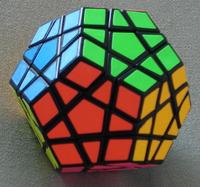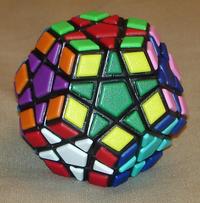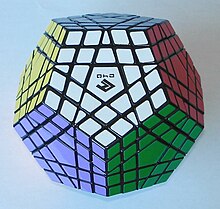Megaminx
The Megaminx is a mechanical, three-dimensional puzzle with a height of about eight and an edge length of about three centimeters and is comparable to the Rubik's Cube and even more so to the Alexander's Star . The Megaminx is a regular dodecahedron with twelve side faces in the form of regular pentagons . Each of the side faces is divided into eleven segments by a pentagram-like star pattern, each of which has the same color.
With the internal rotating mechanism, the side surfaces can be brought into alignment again by rotating 72 ° to five positions around their central axes. In this way, the moving parts change their position in relation to one another and can assume almost any position in the dodecahedron. The goal is usually to bring the Megaminx from a position in which the colors are mixed back to its regular basic position by turning the side surfaces.
history
In the wake of the popularity of the Rubik's Cube in the 1980s, several versions in the shape of a dodecahedron were designed simultaneously as early as 1981. Since the mechanisms were similar nature, there were disputes over patent - and marketing rights . In Germany , Walter Moll received the patent on July 30, 1981. Christoph Bandelow received another patent on October 14, 1982, and in Hungary, Szlivka Ferenc on October 28, 1982 under the name Supernova . The puzzles differed slightly in the width of the edge pieces and thus in appearance. The German puzzle inventor Uwe Mèffert subsequently acquired several national distribution rights. In October 1982, Omni magazine wrote an article about the Megaminx and other cube variants. Since August 2009 Uwe Mèffert has been offering the Holey Megaminx in his shop , a Megaminx that has neither central stones nor a core inside. Instead, it has 30 ball bearings and springs.
In addition to the 3-level Megaminx, there are also other Rubik's Cube dodecahedra. The Kilominx has only 2 levels, so only corner stones, no middle stones and no curb stones. The Gigaminx , which has also been on sale since August 2009, already has 5 levels and consists of 255 parts plus screws. The next versions, Teraminx (7 levels) and Petaminx (9 levels), are not commercially available, the latter consists of 975 parts, which are covered with 1,212 stickers.
Nowadays the Megaminx is only available from specialist retailers and is still very popular among Rubik's fans. This is due on the one hand to the aesthetic design of the puzzle, and on the other hand to the somewhat higher degree of difficulty compared to the cube. Nevertheless, some solution strategies of the cube can be easily modified and transferred to the Megaminx. Also Speedcubing , so as quickly as possible to solve time is operated with the Megaminx, it is even a discipline in official competitions. These competitions are organized by the World Cube Association , or WCA for short . The world record of 27.22 seconds was set by Juan Pablo Huanqui at La Tienda Cubera Christmas 2019 .
Combinations
The Megaminx has 50 moving parts (as opposed to the Rubik's Cube, which only has 20). Of these, 30 are edge pieces with two colors and 20 corner pieces with three colors each. The 12 pentagonal center stones are rotatably mounted on the basic structure of the puzzle and do not change their relative position. This leads to a maximum upper limit of possible combinations of 30! · 20! · 2 30 · 3 20 . Since not every position can be reached due to the mechanism, this number is reduced to 30! · 20! · 2 27 · 3 19 ≈10 68 .
In addition to a version with twelve colors, in which each side is colored differently, there is also a version with six colors, in which the opposite sides are the same color. As a result of each two-tone edge piece there are two identical ones. In the case of the three-colored corner pieces, however, they are all different, because the corner pieces with the same color combination are mirror-symmetrical to each other (different "direction of rotation" of the colors).
Although there are fewer combinations with the six-colored Megaminx, the identical pairs of curb stones cause a new difficulty: Since you cannot tell in advance which one belongs in which position, the puzzle may not be solved despite the correct solution strategy. Then an already sorted part has to be given up again so that two identical pieces can swap positions.
Level of difficulty
Although the Megaminx has far more combinations than the Rubik's Cube, the subjective level of difficulty is not higher. Basically, that's because you have more space to maneuver. If one proceeds according to the method of Lars Petrus and the motto “keep things organized”, one can intuitively, i. H. without following a specific strategy and without complicated sequence of moves, arrange a 2 × 2 × 3 block with the die. Then there are two adjacent side surfaces that are still disordered, which corresponds to 13 edge and corner pieces that can no longer be solved intuitively without having to give up the ordered part again. With the Megaminx, three adjoining side surfaces are left, i.e. 22 disordered pieces. This means that 56% can be solved intuitively with the Megaminx, but only 35% with the cube. This can already be seen from the fact that 40% of the stones are moved with one rotation of the cube, but only 20% of the Megaminx.
Individual evidence
- ^ Patent Walter Moll
- ↑ Patent Szlivka Ferenc
- ↑ Meffert distribution rights
- ↑ mefferts.com - New Puzzle Release (Engl.)
- ↑ Cube4you - Gigaminx (Eng.)
- ↑ PuzzleForge - The Making of The Petaminx
- ↑ the Megaminx Single World Records on the World Cube Association website
Web links
- Jaap's Puzzle Page - Megaminx (English page with solution and further information)
- Megaminx: solution for last layer by Andy Klise and Erik Akkersdijk



